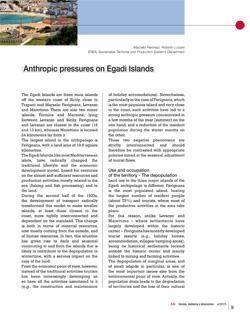
Anthropic pressures on Egadi Islands
M. Peronaci, R. Luciani
The Egadi Islands, like most Mediterranean islets, have radically changed the traditional lifestyle and the economic development model, based for centuries on the almost self-sufficient resources and production activities, mostly related to the sea (fishing and fish processing) and to the land. During the second half of the 1900s, the development of transport radically transformed this model to make smaller islands, at least those closest to the coast, more tightly interconnected and dependent on the mainland. In particular, in Favignana, which is the most populous island and very close to the coast, the traditional activities tourism have led to a strong anthropic pressure concentrated in a few months of the year (summer) on the one hand, and a reduction of the resident population during the winter months on the other, with a serious impact on the care of the land
Pressioni antropiche sulle Isole Egadi
Le Isole Egadi, come la maggior parte delle piccole isole del Mediterraneo, hanno cambiato radicalmente il loro tradizionale stile di vita e modello di sviluppo economico, basato per secoli su risorse e attività produttive quasi autosufficienti, per lo più legate al mare (pesca e lavorazione del pesce) e alla terra. Nella seconda metà del 1900, lo sviluppo dei trasporti ha trasformato radicalmente questo modello facendo diventare le piccole isole, almeno quelle più vicine alla costa, più strettamente interconnesse e dipendenti dalla terraferma. In particolare a Favignana, l'isola più popolata e vicina alla costa, le attività legate al turismo hanno portato ad una forte pressione antropica concentrata in pochi mesi dell'anno (estate), da un lato, e una riduzione della popolazione residente durante i mesi invernali, dall’altro, con un grave impatto sulla cura del territorio

